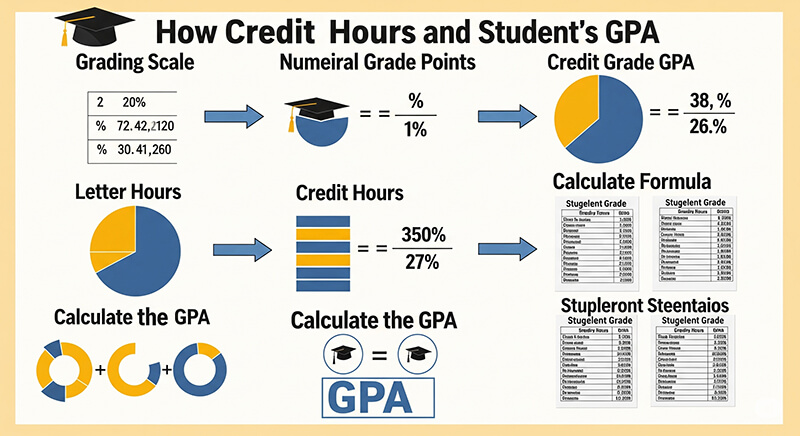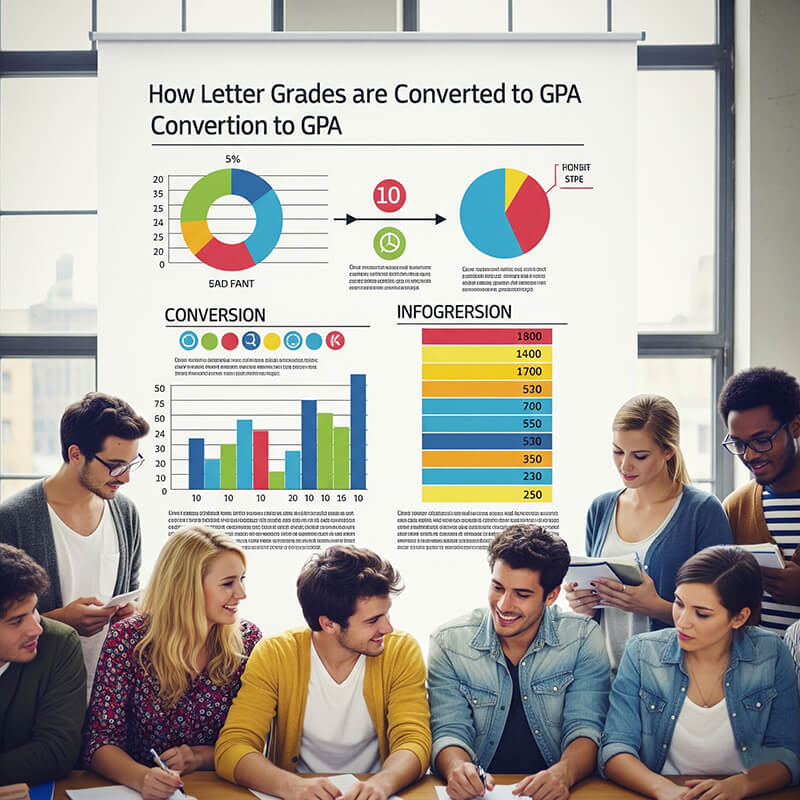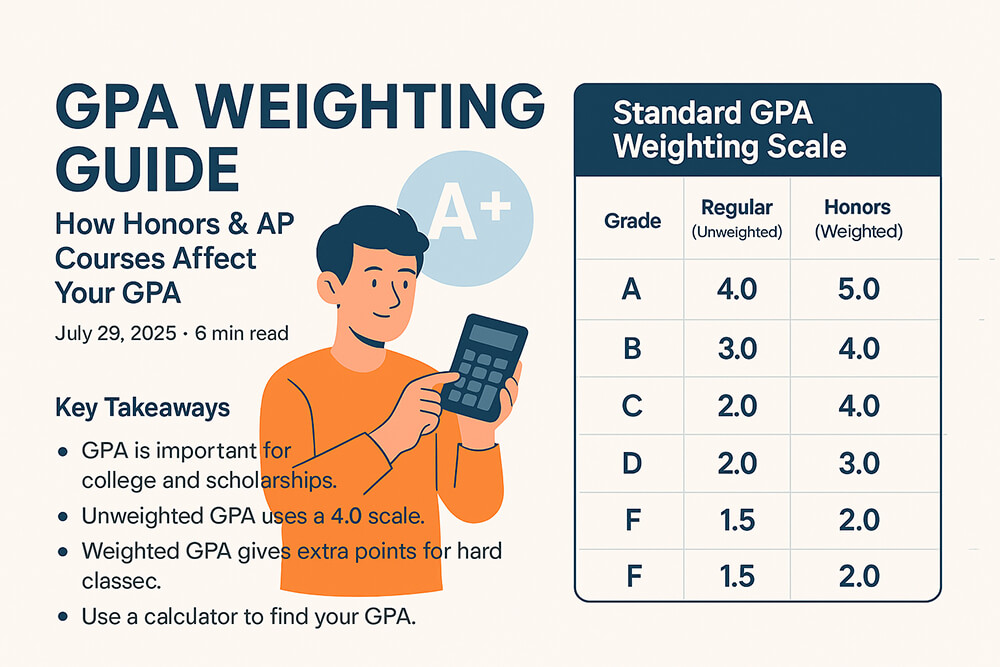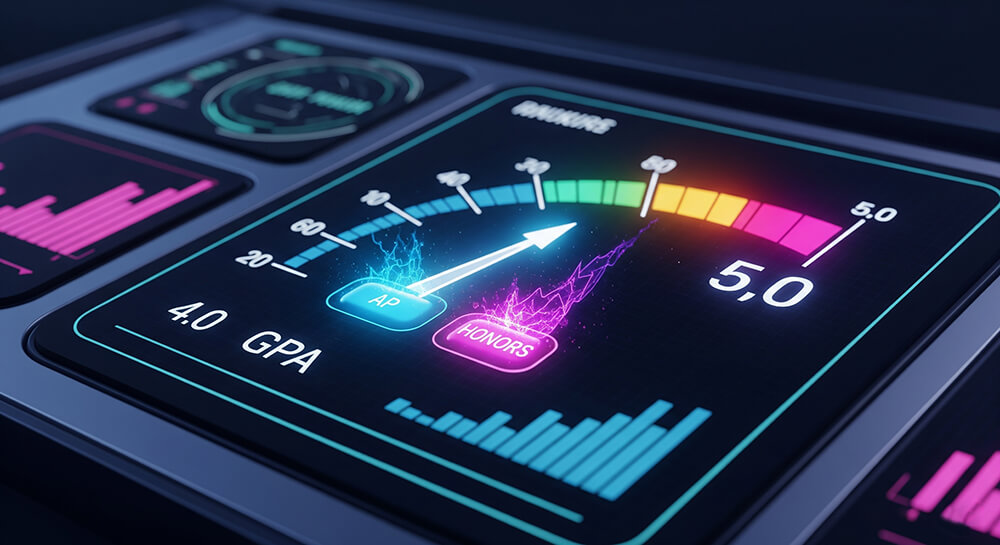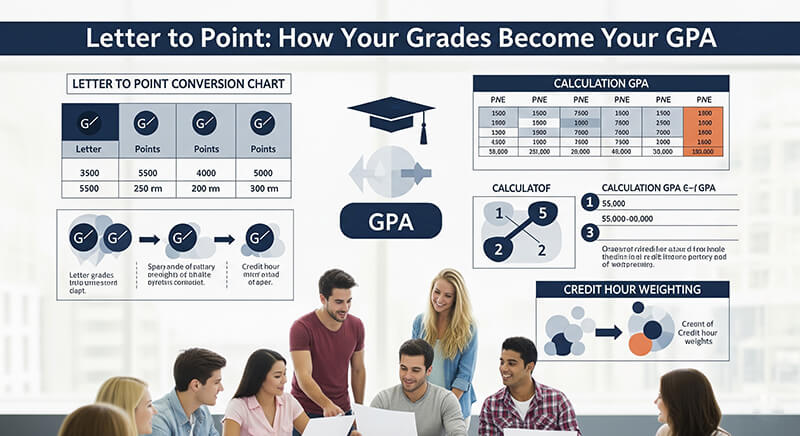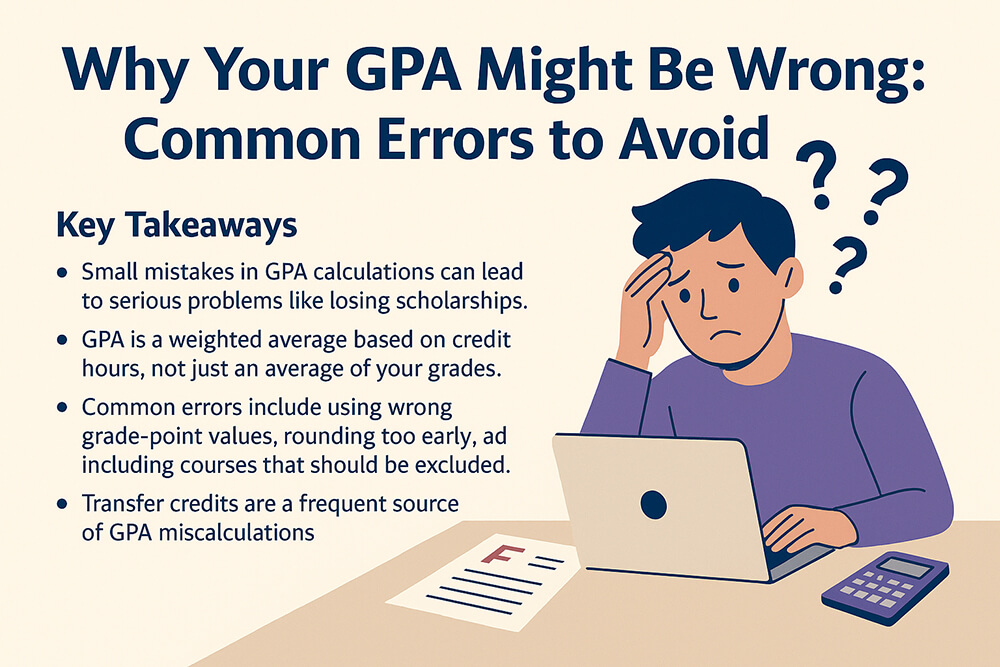Key Takeaways
| Feature | Description | Main Point |
|---|---|---|
| Basic Conversion | The simplest way to estimate your GPA is to convert a percentage to a 4.0 scale. | An A (93%–100%) is a 4.0, a B (83%–86%) is a 3.0, and so on. |
| Weighted vs. Unweighted | Unweighted GPA is on a 4.0 scale. Weighted GPA includes extra points for advanced classes. | Honors classes often add 0.5 points, while AP/IB classes add 1.0 point. |
| The 5.0 Scale | The weighted system allows students to earn a GPA higher than 4.0, often up to a 5.0. | A 5.0 GPA is possible by taking and excelling in many weighted courses like AP or IB. |
| Institutional Differences | Each school district and university has its own rules for GPA calculation. | Your 90% might be a 3.7 at one school but a 4.0 at another. |
| Common Errors | Simple mistakes like incorrect rounding or miscalculating weighted credits can change your GPA. | Always double-check your math and understand your school's specific policies. |
Understanding the Basics: From Percentages to Points
Converting your percentage grades into a Grade Point Average (GPA) is a common need for students. The 4.0 scale is the most widely used system in the United States. At its core, this system assigns a point value to the range of percentages you earn in a class. For example, a percentage of 95% is an "A" grade, which equals 4.0 points. A lower percentage, like 85%, is a "B" and equals 3.0 points. This method turns your varied percentages into a single, standard number. You can find a detailed GPA formula guide to see the math behind it.
A simple way to think about it is with a basic formula. The most direct, though not always exact, method is to divide your percentage by 100 and multiply by 4. To learn more about the fundamentals, explore this guide on how to calculate GPA.
The Standard Unweighted 4.0 GPA Scale
The unweighted GPA scale is the simplest form of GPA calculation. It does not account for the difficulty of your classes. An "A" in a standard class receives the same points as an "A" in an advanced class. The conversion from percentage to points is straightforward. Each letter grade corresponds to a specific point value on the 4.0 scale. Understanding the difference between quality points vs. GPA explained is key to grasping this concept.
Here is a standard conversion chart:
| Letter Grade | Percentage | GPA (4.0) |
|---|---|---|
| A+ | 97–100 | 4.0 |
| A | 93–96 | 4.0 |
| A- | 90–92 | 3.7 |
| B+ | 87–89 | 3.3 |
| B | 83–86 | 3.0 |
| B- | 80–82 | 2.7 |
| C+ | 77–79 | 2.3 |
| C | 73–76 | 2.0 |
| C- | 70–72 | 1.7 |
| D+ | 67–69 | 1.3 |
| D | 65–66 | 1.0 |
| F | <65 | 0.0 |
This table is a helpful reference, and a letter to point GPA conversion guide can offer more detail.
Weighted vs. Unweighted GPA: What's the Difference?
The main difference between weighted and unweighted GPA is how it treats course difficulty. An unweighted GPA is always on a 4.0 scale. A weighted GPA gives more weight to more challenging classes, like Honors or Advanced Placement (AP). This means an "A" in an AP class is worth more than an "A" in a regular class. Many schools use a weighted vs. unweighted GPA calculator to show students both scores.
This system is designed to reward students for taking on tougher academic challenges. Knowing the weighted vs. unweighted GPA distinction is important for college applications, as over 70% of U.S. high schools use weighted GPAs.
How Honors and AP Courses Boost Your GPA
Honors and AP courses are designed to be more difficult than standard-level classes. To reward students for this extra effort, most schools add "weight" to these grades. Typically, an Honors course adds an extra 0.5 points to the GPA value for that class. An AP or IB course often adds a full 1.0 point. For example, an "A" in a regular class is a 4.0, but in an AP class, it becomes a 5.0. A helpful GPA weighting guide for Honors and AP can explain this in more detail.
This weighting system is why some students have GPAs above 4.0. It is important to understand these benefits and not fall for common weighted GPA myths debunked.
Beyond the 4.0: The 5.0 GPA Scale Explained
When you hear about a 5.0 GPA, it refers to a weighted scale. Because AP and IB classes can add a full point to your grade's value, earning an "A" in these courses results in a 5.0 for that class. If a student takes many weighted classes and earns high grades, their cumulative GPA can exceed 4.0. This is explained in detail within a 5.0 GPA scale guide. International Baccalaureate (IB) programs also use a unique grading system, and an IB to GPA conversion guide is useful for those students.
Calculating Your GPA for Different Scenarios
Your GPA calculation needs can change based on your academic level. A high school student may need a high school GPA calculator that factors in different course levels. A college student, on the other hand, will use a college GPA calculator that focuses on credit hours. For students in unique programs, like those on a different academic calendar, a trimester GPA calculator might be necessary. It's also wise for new students to use a freshman year GPA predictor to set goals.
Tools for Every Academic Situation
Managing your GPA requires the right tools. For a look at your overall academic performance, a cumulative GPA calculator is essential. To track your progress during a specific term, a semester GPA calculator provides a clear snapshot. Students taking many courses may benefit from a multi-semester GPA bulk import tool to save time. For those looking ahead, a mid-term grade projection slider can help estimate final grades.
Handling Special Grade Situations
Not all grades fit neatly into the A-F system. Pass/fail classes, for instance, can be tricky. A guide on how pass/fail grades impact your GPA explains that they usually don't affect your GPA unless you fail. Incomplete grades are another special case. A GPA planning for incomplete grades resource can help you prepare, while an incomplete grades scenario planner lets you see potential outcomes. Other unique situations include transfer credits, which can be managed with a transfer-credits-gpa-integrator.
Advanced GPA Calculation and Analysis
Once you understand the basics, you can use more advanced tools for deeper insights. A GPA trend graph generator can visualize your academic progress over time, which is great for college applications. If you are considering switching fields of study, a major change GPA impact tool can show you how that decision might affect your grades. You can also separate your performance in different subjects with a core vs. elective GPA calculator or a prerequisite-only GPA calculator.
Common Mistakes in GPA Conversion
Calculating your GPA seems simple, but small errors can lead to the wrong number. One of the most frequent issues is not knowing your school's specific policies on weighting and grade cutoffs. A guide on common GPA calculation errors to avoid can help prevent these mistakes. It is also a good practice to perform a regular transcript GPA audit guide to ensure everything is accurate. Forgetting to factor in repeated courses correctly is another pitfall, where a repeat course GPA recalculator is useful.
Why School Policies Matter
A percentage-to-GPA conversion chart is not universal. Every school district and university sets its own rules. A guide on how school districts calculate GPA shows how policies can vary from one place to another. Some schools might consider a 92% an A-, while others count it as an A. This can also lead to GPA inflation vs. deflation, where grades at one school are worth more than at another. Always check your school's official handbook or website for the most accurate information.
Frequently Asked Questions (FAQ)
What is the simplest formula to convert a percentage to a 4.0 GPA? A common estimation formula is (Percentage / 100) * 4. For example, an 85% would be (85 / 100) * 4 = 3.4. However, this method does not account for plus/minus grades or specific school policies.
How do I handle weighted grades for AP or Honors classes? For weighted grades, you typically add extra points. Many schools add 0.5 points for an Honors class and 1.0 point for an AP or IB class. An 'A' in an AP class could be worth 5.0 points instead of 4.0.
Does every school use the same conversion chart? No. Each school or district sets its own grading policy. The percentage range for an 'A' or 'B' can differ, which changes the GPA conversion. Always refer to your specific institution's guidelines.
What is the difference between a 4.0 and a 5.0 scale? A 4.0 scale is typically unweighted, meaning all classes are graded the same. A 5.0 scale is weighted, allowing students to earn above a 4.0 by taking advanced courses like AP or Honors where an 'A' is worth 5.0 points.

